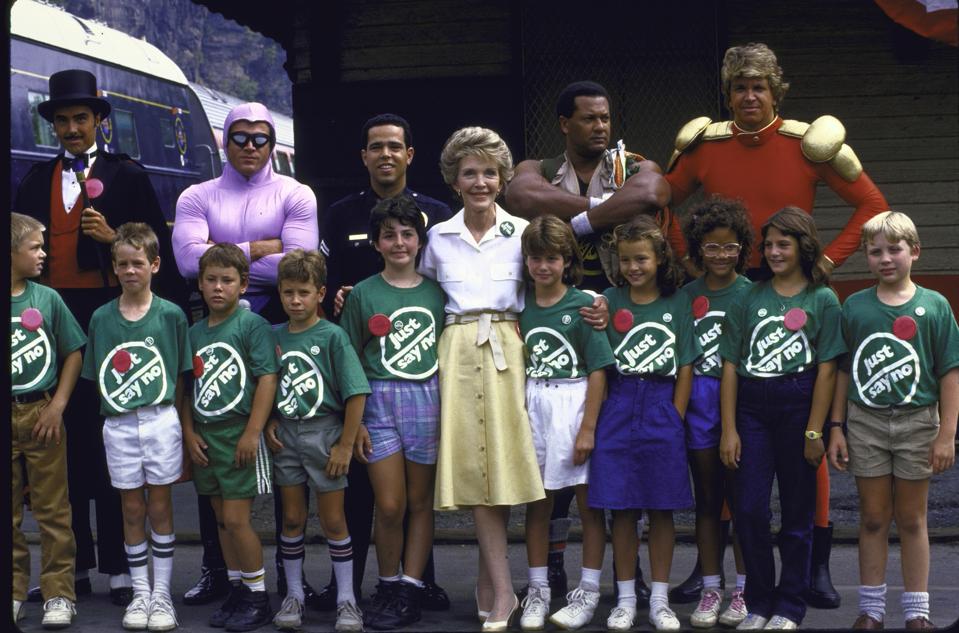Americans embarked on two soft power initiatives to eradicate drug abuse in the 1980s.
Both were well-intentioned attempts to stem national tragedies—to save lives, families, and livelihoods.
However their results differed radically, and we learned a lot about how soft power works or fails.
DARE To Be Great
One was the expansion of the Nixon era “war on drugs” into a multi-faceted virtue-building campaign in the form of then-First Lady Nancy Reagan’s “Just Say No” push and the work of DARE—Drug Abuse Resistance Education campaign.
DARE had quite a thesis: it held that teenagers were morally lacking. They too often had no sense of personal responsibility, low self-esteem, inability to resist peer pressure, and low respect for law-enforcement.
DARE was expansive in its ambitions, pushing for zero-tolerance on cigarettes, alcohol, and illicit drugs while also promoting sturdy family values.
Growing up in Los Angeles, the birthplace of the DARE campaign, I participated in the program. It seemed to be countless films and ominous lectures by LAPD officers followed by a pledge I didn’t quite understand. Yet, it soon became a staple of education in southern California and beyond.
By its 10-year anniversary, the program operated in 5,200 communities across all 50 states, had reached more than 5 millions school kids, and had expanded overseas.
Who’s Driving Tonight?
The other initiative—creation of the “designated driver” norm to oblige drinkers to ask a sober person to drive on their behalf—was more limited in its goals.
Started by the Harvard School of Public Health’s Center for Health Communications in 1988, largely eschewed moral judgment and focused on outcomes. It assumed, for example, that some or all of those in the company of the driver would have greater leeway to consume in excess.
The designated driver campaign also differed from DARE in its philosophy of communicating its ideas. Rather than putting thousands of uniformed officers in an unfamiliar setting, it sought out the producers of more than 150 prime-time television shows, including nationwide staples such as Cheers, L.A. Law, and The Cosby Show, and enlisted them to sprinkle designated driver references into their scripts.
Rather than stern, rehearsed lectures, American teens were given short, casual messages in dialogue form.
Within three years, the phrase had entered the Random House Webster’s College dictionary, and the Roper Organization found strong and widespread approval for the concept of designated drivers—more than 90 percent.
Numbers Don’t Lie
Today, DARE stands as an object lesson in how not to use soft power.
At its start, DARE seemed to have everything going for it: a get-tough message that went with the spirit of the times, enthusiastic support from school boards, and financing from corporations interested in responsible, feel-good brand vibes. It just didn’t have results.
By 1991, more than a dozen independent studies had found a disheartening conclusion: there was little if any credible, measurable evidence that it reduced illegal drug use. So damning was the accumulation of poor evidence that DARE began a marked decline in size, prestige, and resources.
Meanwhile, the more narrowly tailored and evidence-based push to expand the use of designated drivers became pervasive. Highway roadblocks find a significant percentage of designated drivers. Aided by the efforts of Mothers Against Drunk Driving and stiffer drunk driving penalties, traffic fatalities climbed downward. A new norm, however imperfect, had taken hold.
Soft Power Lessons
We are in the midst of a national tragedy. At a time when opioid abuse fatalities have climbed to roughly more than 100,000 per year, we need every bit of wisdom and efficiency we can find.
We could do worse than heed the insights of Jay Winsten, one of the principal architects of the designated driver campaign.
When seeking to change norms, focus on specific targets that can be measured and communicated clearly.
Rather than a wholesale change in culture or ideology through negative messages, aim for a small, concrete, measurable change through positive messages.
Take advantage of priming. If possible, build on the priming work of other nations or like-minded organizations.
If these lessons seem obvious, we should recall that DARE seemed obviously correct, too. The use of soft power rarely succeeds or fails categorically. However, the extent of one’s ambition and independent review are critical.
Soft power—the gradual changing of social norms—does work, albeit not always well or in the ways we expect. But it has become a permanent part of the public policy toolkit that deserves more understanding, research, and resources.

